Innovative Urban Blue Space Design in a Changing Climate: Transition Models in the Baltic Sea Region
Abstract
1. Introduction
Transformations of the Land–Water Boundary
2. Materials and Methods
2.1. Methodological Framework
- Geographic Information System (GIS) maps and geoportals enabled the exploration of complex spatial relationships and patterns due to integrated data from various sources associated with specific geographic locations. Online geoportals (referred to as geographic data portals or geospatial data portals) were accessed to obtain spatial data and visualize the study areas;
- CAD mapper—this online platform offered access to a wide range of geographic and architectural data in Computer-Aided Design (CAD) format. It was used to generate maps, which were then imported into the AUTODESK AutoCAD 2022 program to create research cartographic materials;
- Planning strategies documents for cities published on municipal web pages were explored to gather information on the characteristics of transformation processes and their guiding objectives;
- Architectural and urban design projects and their briefs obtained from the architectural studios’ databases were accessed to collect materials related to the transformation of the study areas;
- Scientific articles related to urban form, waterfront public space transformations, and climate adaptation measures were reviewed to provide the theoretical framework.
- Different sizes of the cities;
- Different locations in the city structure;
- Different types of waterbodies and shorelines;
- Different climate conditions.
- Geographic and Climatic Diversity: The selected cities cover a wide geographic range, spanning across the Baltic Sea Region. They are located by different types of waterbodies, including gulfs, bays, open Baltic Sea coastlines, straits, and rivers [64]. Each city’s surroundings offer diverse coastal ecosystems, such as estuaries, wetlands, sandy beaches, and rocky shores. This diversity allows for studying land–water interfaces in various coastal and urban environments, each with unique characteristics and challenges.
- Different Governance Systems: The selected cities are located in four different countries, each with its own governance systems and policies regarding urban and coastal management, as well as land–water interfaces [65,66,67]. Comparative research among these cities can reveal effective strategies and best practices for urban coastal resilience and sustainability. Moreover, the inclusion of cities from different countries fosters opportunities for transboundary collaboration on urban waterfronts. This can lead to joint initiatives, data sharing, and collaborative efforts in addressing shared coastal and urban challenges.
- Urbanization and Human Impact: Several of the cities are major urban centres and industrial hubs, leading to significant human impact on the coastal areas, while others are smaller cities and towns. Studying the transformation of land–water interfaces in all these cases is crucial for understanding the interaction between human activities and waterfronts.
- Coastal Vulnerability: Many of these cities are located along coastlines that are vulnerable to environmental changes, including sea level rise, erosion, and extreme weather events [68,69,70]. Investigating the morphology of newly created blue public spaces provides valuable insights into possible paths for waterfront transformation and may contribute to informing future sustainable management practices in the Baltic Sea Region and beyond.
- Different Coastal Infrastructure: The selected cities have varying degrees of coastal infrastructure development that result from the former land use patterns.
2.2. Study Area
2.2.1. Study Case Setting and Background
2.2.2. Characteristics of the Baltic Sea Region
2.2.3. Description of the Research Outline
- Rocky shores characterized by rugged, rocky terrain with steep cliffs or rocky beaches are present along the northern coast of the Baltic Sea in countries such as Finland, Estonia, and Sweden—for example, the granite cliffs of the Höga Kusten in Sweden, which rise over 300 m above the sea;
- Sandy beaches characterized by wide stretches of sand and dunes are common along the coasts of Sweden, Poland, and Denmark, such as the white sand beaches of the island of Bornholm;
- Mudflats characterized by soft, muddy terrain and shallow water depths are common in the southern part of the Baltic Sea in countries such as Poland and Germany, such as the Wattenmeer along the German coast;
- Salt marshes characterized by low-lying, marshy terrain and the presence of salt-tolerant vegetation are present in the northern part of the Baltic Sea in countries such as Sweden and Finland, such as the Kvarken Archipelago (Kvarken skärgård);
- Estuaries characterized by the dynamic flow of freshwater and saltwater as rivers meet the sea, which are common in the Gulf of Bothnia and in the Gulf of Finland, such as the River Kymi (Kymijoki) estuary in Finland—which is a Ramsar wetland site;
- Archipelagos characterized by clusters of small islands and rocky outcrops are common throughout the Baltic Sea Region, including Sweden, Finland, and Estonia, such as the Åland Islands in Finland, which include over 6000 islands and islets.
3. Results
4. Discussion
5. Conclusions
Author Contributions
Funding
Data Availability Statement
Conflicts of Interest
References
- Alemany, J.; Bruttomesso, R. (Eds.) The Port City of the XXIst Century; RETE: Venice, Italy, 2011. [Google Scholar]
- Braae, E.; Diedrich, L. Site specificity in contemporary large-scale harbour transformation projects. J. Landsc. Archit. 2012, 7, 20–33. [Google Scholar] [CrossRef][Green Version]
- Lorens, P. Urban waterfront regeneration: Origins of the issue. In New Faces of Harbor Cities; Cambridge Scholars Publishing: Newcastle upon Tyne, UK, 2014. [Google Scholar]
- Hein, C.; Schubert, D. Resilience and Path Dependence: A Comparative Study of the Port Cities of London, Hamburg, and Philadelphia. J. Urban Hist. 2021, 47, 389–419. [Google Scholar] [CrossRef]
- Porfyriou, H.; Sepe, M. Waterfronts Revisited: European Ports in a Historic and Global Perspective; Routledge: New York, NY, USA, 2017. [Google Scholar]
- United Nations. The Sustainable Development Goals Report 2019; UN: New York, NY, USA, 2019. [Google Scholar]
- 10 Principles for Sustainable Development of Urban Waterfront Areas. Cities on Water in Collaboration Wasserstadt GmbH, Berlin. In Proceedings of the International Seminars: Global Conference on the Urban Future (URBAN 21), EXPO 2000 World Exhibition, Berlin, Germany, 1 June–31 October 2000. [Google Scholar]
- Bell, S.; Fleming, L.E.; Grellier, J.; Kuhlmann, F.; Nieuwenhuijsen, M.J.; White, M.P. Urban Blue Spaces: Planning and Design for Water, Health and Well-Being, 1st ed.; Routledge: London, UK, 2021. [Google Scholar]
- Wilczyńska, A.; Niin, G.; Vassiljev, P.; Myszka, I.; Bell, S. Perceptions and Patterns of Use of Blue Spaces in Selected European Cities: Tartu, Tallinn, Barcelona, Warsaw and Plymouth. Sustainability 2023, 15, 7392. [Google Scholar] [CrossRef]
- Ptak-Wojciechowska, A.; Januchta-Szostak, A.; Gawlak, A.; Matuszewska, M. The Importance of Water and Climate-Related Aspects in the Quality of Urban Life Assessment. Sustainability 2021, 13, 6573. [Google Scholar] [CrossRef]
- Zhang, H.; Nijhuis, S.; Newton, C. Freshwater blue space design and human health: A comprehensive research mapping based on scientometric analysis. Environ. Impact Assess. Rev. 2022, 97, 106859. [Google Scholar] [CrossRef]
- Hein, C. Port cities and urban wealth: Between global networks and local transformations. Int. J. Glob. Environ. Issues 2014, 13, 339–361. [Google Scholar] [CrossRef]
- Schubert, D. Ports and Urban Waterfronts. In The Routledge Handbook of Planning History; Hein, C., Ed.; Routledge: New York, NY, USA, 2018; pp. 338–349. [Google Scholar]
- Hein, C.; van Mil, Y. Towards a comparative spatial analysis for port city regions based on historical geospatial mapping. PORTUSplus 2019, 8, 2–18. [Google Scholar]
- Krośnicka, K.A.; Lorens, P.; Michałowska, E. Port cities within port regions: Shaping complex urban environments in Gdansk Bay, Poland. Urban Plan. 2021, 6, 27–42. [Google Scholar] [CrossRef]
- Giovinazzi, O.; Moretti, M. Port Cities and Urban Waterfront: Transformations and Opportunities. TeMALab J. Mobil. Land Use Environ. 2010, 3, 57–64. [Google Scholar]
- Cin, F.D.; Hooimeijer, F.; Silva, M.M. Planning the Urban Waterfront Transformation, from Infrastructures to Public Space Design in a Sea-Level Rise Scenario: The European Union Prize for Contemporary Architecture Case. Water 2021, 13, 218. [Google Scholar] [CrossRef]
- Climate Central. Researching and Communicating Climate Change Impacts and Solutions. Available online: https://www.climatecentral.org/ (accessed on 12 July 2022).
- MIT Climate Models. Available online: https://climate.mit.edu/explainers/climate-models (accessed on 25 July 2022).
- Matos Silva, M.; Costa, J.P. Flood Adaptation Measures Applicable in the Design of Urban Public Spaces: Proposal for a Conceptual Framework. Water 2016, 8, 284. [Google Scholar] [CrossRef]
- Hurlimann, A.; Wilson, E. Sustainable Urban Water Management under a Changing Climate: The Role of Spatial Planning. Water 2018, 10, 546. [Google Scholar] [CrossRef]
- Liu, J.; Fan, B. What Contributes to Local-Level Institutional Adaptation under Climate Change? A Configurational Approach Based on Evidence from China’s Sponge City Program. J. Environ. Manag. 2023, 342, 118292. [Google Scholar] [CrossRef] [PubMed]
- Dong, X.; Ye, Y.; Yang, R.; Li, X. Planning for green infrastructure based on integration of multi-driving factors: A case study in pilot site of sponge city. Sustain. Cities Soc. 2023, 93, 104549. [Google Scholar] [CrossRef]
- Zhai, J.; Ren, J.; Xi, M.; Tang, X.; Zhang, Y. Multiscale watershed landscape infrastructure: Integrated system design for sponge city development. Urban For. Urban Green. 2021, 60, 127060. [Google Scholar] [CrossRef]
- Ferrans, P.; Torres, M.N.; Temprano, J.; Sánchez, J.P.R. Sustainable Urban Drainage System (SUDS) modeling supporting decision-making: A systematic quantitative review. Sci. Total Environ. 2021, 806, 150447. [Google Scholar] [CrossRef]
- Ferrans, P.; Reyes-Silva, J.D.; Krebs, P.; Temprano, J. Flood Management with SUDS: A Simulation–Optimization Framework. Water 2023, 15, 426. [Google Scholar] [CrossRef]
- Fletcher, T.D.; Shuster, W.; Hunt, W.F.; Ashley, R.; Butler, D.; Arthur, S.; Trowsdale, S.; Barraud, S.; Semadeni-Davies, A.; Bertrand-Krajewski, J.L.; et al. SUDS, LID, BMPs, WSUD and more—The evolution and application of terminology surrounding urban drainage. Urban Water J. 2015, 12, 525–542. [Google Scholar] [CrossRef]
- Nesbitt, L.; Meitner, M.J.; Sheppard, S.R.; Girling, C. The dimensions of urban green equity: A framework for analysis. Urban For. Urban Green. 2018, 34, 240–248. [Google Scholar] [CrossRef]
- Nesbitt, L.; Meitner, M.J.; Girling, C.; Sheppard, S.R.; Lu, Y. Who has access to urban vegetation? A spatial analysis of distributional green equity in 10 US cities. Landsc. Urban Plan. 2019, 181, 51–79. [Google Scholar] [CrossRef]
- Kabisch, N.; Frantzeskaki, N.; Hansen, R. Principles for urban nature-based solutions. Ambio 2022, 51, 1388–1401. [Google Scholar] [CrossRef] [PubMed]
- Matos Silva, M.; Costa, J.P. Urban flood adaptation through public space retrofits: The case of Lisbon (Portugal). Sustainability 2017, 9, 816. [Google Scholar] [CrossRef]
- Matos Silva, M.; Costa, J.P. Urban Floods and Climate Change Adaptation: The Potential of Public Space Design When Accommodating Natural Processes. Water 2018, 10, 180. [Google Scholar] [CrossRef]
- Burda, I.; Nyka, L. Providing Public Space Continuities in Post-Industrial Areas through Remodelling Land/Water Connections. IOP Conf. Ser. Mater. Sci. Eng. 2017, 245, 082037. [Google Scholar] [CrossRef]
- Piątek, Ł.; Wojnowska-Heciak, M. Multicase Study Comparison of Different Types of Flood-Resilient Buildings (Elevated, Amphibious, and Floating) at the Vistula River in Warsaw, Poland. Sustainability 2020, 12, 9725. [Google Scholar] [CrossRef]
- Dubinina, A.; Wawrzyńska, A.; Krośnicka, K. Permeability of Waterfronts—Contemporary Approach in Designing Urban Blue Spaces. Sustainability 2022, 14, 9357. [Google Scholar] [CrossRef]
- Nyka, L.; Burda, I. Scenario-planning solutions for waterfront flood-prone areas. Glob. J. Eng. Educ. 2020, 22, 149–154. [Google Scholar]
- On the Water: Palisade Bay; The Museum of Modern Art MoMA: New York, NY, USA; Princeton University School of Architecture: Princeton, NJ, USA, 2010.
- BACA. ‘The LifE Report’ by IHS, BRE Press along with a Condensed Illustrated ‘LifE Handbook’; The Life Report; de Bre and Baca Architects: London, UK, 2009. [Google Scholar]
- Olthuis, K.; Keuning, D. Float! Building on Water to Combat Urban Congestion and Climate Change; Frame Publishers: Amsterdam, The Netherlands, 2010. [Google Scholar]
- Loes Nillesen, A.; Singelenberg, J. Amphibious Housing in the Netherlands; NAi Publishers: Rotterdam, The Netherlands, 2011. [Google Scholar]
- Molinaroli, E.; Peschiutta, M.; Rizzetto, F. Long-Term Evolution of an Urban Barrier Island: The Case of Venice Lido (Northern Adriatic Sea, Italy). Water 2023, 15, 1927. [Google Scholar] [CrossRef]
- Shannon, K.; De Meulder, B.; d’Auria, V.; Gosseye, J. (Eds.) Water Urbanisms; SUN: Amsterdam, The Netherlands, 2008. [Google Scholar]
- Ghermandi, A.; Nunes, P.A. A global map of coastal recreation values: Results from a spatially explicit meta-analysis. Ecol. Econ. 2013, 86, 1–15. [Google Scholar] [CrossRef]
- Dangendorf, S.; Marcos, M.; Wöppelmann, G.; Conrad, C.P.; Frederikse, T.; Riva, R. Reassessment of 20th-century global mean sea level rise. Proc. Natl. Acad. Sci. USA 2017, 114, 5946–5951. [Google Scholar] [CrossRef]
- Kulp, S.A.; Strauss, B.H. New elevation data triple estimates of global vulnerability to sea-level rise and coastal flooding. Nat. Commun. 2019, 10, 4844. [Google Scholar] [CrossRef]
- Restemeyer, B.; Woltjer, J.; van den Brink, M. A strategy-based framework for assessing the flood resilience of cities—A Hamburg case study. Plan. Theory Pract. 2015, 16, 45–62. [Google Scholar] [CrossRef]
- White, P.; Pelling, M.; Sen, K.; Seddon, D.; Russell, S.; Few, R. Disaster Risk Reduction: A Development Concern. A Scoping Study on Links between Disaster Risk Reduction, Poverty and Development; Department for International Development: London, UK, 2005. [Google Scholar]
- Kabisch, N.; Frantzeskaki, N.; Pauleit, S.; Naumann, S.; Davis, M.; Artmann, M.; Haase, D.; Knapp, S.; Korn, H.; Stadler, J.; et al. Nature-Based Solutions to Climate Change Mitigation and Adaptation in Urban Areas: Perspectives on Indicators, Knowledge gaps, Barriers, and Opportunities for Action. Ecol. Soc. 2016, 21, 39. Available online: http://www.jstor.org/stable/26270403 (accessed on 10 October 2022). [CrossRef]
- Collins, M.; Sutherland, M.; Bouwer, L.; Cheong, S.-M.; Frölicher, T.; Des Combes, H.J.; Roxy, M.K.; Losada, I.; McInnes, K.; Ratter, B.; et al. Chapter 6: Extremes, Abrupt Changes and Managing Risks. ipcc SROCC 2019, 589–655. [Google Scholar] [CrossRef]
- Wolff, C.; Nikoletopoulos, T.; Hinkel, J.; Vafeidis, A.T. Future urban development exacerbates coastal exposure in the Mediterranean. Sci. Rep. 2020, 10, 14420. [Google Scholar] [CrossRef] [PubMed]
- Oppenheimer, M. Preface. In On the Water: Palisade Bay; Nordenson, G., Seavitt, C., Yarinsky, A., Eds.; The Museum of Modern Art: New York, NY, USA, 2010; p. 11. [Google Scholar]
- Cooper, M.P.; Beevers, M.D.; Oppenheimer, M. The Potential Impacts of Sea Level Rise on the Coastal Region of New Jersey, USA. Clim. Chang. 2008, 90, 475–492. [Google Scholar] [CrossRef]
- Falkenmark, M.; Mikulski, Z. The Key Role of Water in the Landscape System: Conceptualization to Address Growing Human Landscape Pressures. Geo J. 1994, 33, 355–363. Available online: http://www.jstor.org/stable/41146234 (accessed on 7 September 2021). [CrossRef]
- Wang, J.; Soininen, J.; Heino, J. Ecological indicators for aquatic biodiversity, ecosystem functions, human activities and climate change. Ecol. Indic. 2021, 132, 108250. [Google Scholar] [CrossRef]
- Arnberger, A.; Eder, R.; Preisel, H. Assessing Visitors’ Understanding of River National Park Functions and Landscapes. Water 2023, 15, 461. [Google Scholar] [CrossRef]
- Völker, S.; Matros, J.; Claßen, T. Determining Urban Open Spaces for Health-Related Appropriations: A Qualitative Analysis on the Significance of Blue Space. Environ. Earth Sci. 2016, 75, 1067. [Google Scholar] [CrossRef]
- Keniger, L.E.; Gaston, K.J.; Irvine, K.N.; Fuller, R.A. What are the benefits of interacting with nature? Int. J. Environ. Res. Public Health 2013, 10, 913–935. [Google Scholar] [CrossRef]
- Mobaraki, A.; Oktay Vehbi, B. A Conceptual Model for Assessing the Relationship between Urban Morphology and Sustainable Urban Form. Sustainability 2022, 14, 2884. [Google Scholar] [CrossRef]
- Leccis, F. Urban Regeneration and Touristification in the Sardinian Capital City of Cagliari, Italy. Sustainability 2023, 15, 4061. [Google Scholar] [CrossRef]
- Piwowarczyk, J.; Gee, K.; Gilek, M.; Hassler, B.; Luttmann, A.; Maack, L.; Matczak, M.; Morf, A.; Saunders, F.; Stalmokaitė, I.; et al. Insights into integration challenges in the Baltic Sea Region marine spatial planning: Implications for the HELCOM-VASAB principles. Ocean Coast. Manag. 2019, 175, 98–109. [Google Scholar] [CrossRef]
- VASAB. Vision for the Territorial Development of the Baltic Sea Region in 2040, V.A.S.A.B. Visions and Strategies around the Baltic Sea. Available online: https://vasab.org/vision2040/ (accessed on 30 July 2022).
- HELCOM. Baltic Marine Environment Protection Commission. Available online: https://helcom.fi/ (accessed on 30 July 2022).
- Eurostat, ec. europa.eu/Eurostat/Web/Main/Data/Database. Available online: https://www.citypopulation.de (accessed on 10 May 2023).
- Wolski, T.; Wiśniewski, B. Geographical diversity in the occurrence of extreme sea levels on the coasts of the Baltic Sea. J. Sea Res. 2020, 159, 101890. [Google Scholar] [CrossRef]
- Kern, K. Governance for Sustainable Development in the Baltic Sea Region. J. Balt. Stud. 2011, 42, 21–35. Available online: https://www.jstor.org/stable/43213001. (accessed on 31 July 2023). [CrossRef]
- Grönholm, S. A tangled web: Baltic Sea Region governance through networks. Mar. Policy 2018, 98, 201–210. [Google Scholar] [CrossRef]
- Multi-Level Governance in MSP throughout the Baltic Sea Region. Available online: https://maritime-spatial-planning.ec.europa.eu/projects/multi-level-governance-msp-throughout-baltic-sea-region (accessed on 30 July 2022).
- Klein, R.T.; Nicholls, R.J. Assessment of coastal vulnerability to climate change. Ambio 1999, 28, 182–187. [Google Scholar]
- Sterr, H. Assessment of Vulnerability and Adaptation to Sea-Level Rise for the Coastal Zone of Germany. J. Coast. Res. 2008, 242, 380–393. [Google Scholar] [CrossRef]
- Šakurova, I.; Kondrat, V.; Baltranaitė, E.; Vasiliauskienė, E.; Kelpšaitė-Rimkienė, L. Assessment of Coastal Morphology on the South-Eastern Baltic Sea Coast: The Case of Lithuania. Water 2023, 15, 79. [Google Scholar] [CrossRef]
- Carmona, M.; Heath, T.; Tiesdell, S.; Oc, T. Public Places Urban Spaces. The Dimensions of Urban Design; Elsevier Architectural Press: Oxford 2003.
- Oliveira, V. Urban Morphology: An Introduction to the Study of the Physical From of Cities; Springer International Publishing: Cham, Switzerland, 2016. [Google Scholar]
- Zhou, Q.; Bao, J.; Liu, H. Mapping Urban Forms Worldwide: An Analysis of 8910 Street Networks and 25 Indicators. ISPRS Int. J. Geo-Inf. 2022, 11, 370. [Google Scholar] [CrossRef]
- Borucka, J. Building culture written into the landscape—How to read spatial tradition. In Structures and Architecture Beyond Their Limits; Paulo, J., da Sousa, C., Eds.; CRC Press: Boca Raton, FL, USA; London, UK; New York, NY, USA, 2016; pp. 459–466. [Google Scholar]
- Nochian, A.; Mohd Tahir, O.; Maulan, S.; Rakhshandehroo, M. A Comprehensive Public Open Space Categorization Using Classification System for Sustainable Development of Public Open Spaces. Int. J. Sustain. Trop. Des. Res. Pract. 2015, 8, 29–40. [Google Scholar]
- Weisse, R.; Dailidienė, I.; Hünicke, B.; Kahma, K.; Madsen, K.; Omstedt, A.; Parnell, K.; Schöne, T.; Soomere, T.; Zhang, W.; et al. Sea level dynamics and coastal erosion in the Baltic Sea region. Earth Syst. Dyn. 2021, 12, 871–898. [Google Scholar] [CrossRef]
- Strandmark, A.; Bring, A.; Cousins, S.A.; Destouni, G.; Kautsky, H.; Kolb, G.S.; de la Torre-Castro, M.; Hambäck, P.A. Climate change effects on the Baltic Sea borderland between land and sea. Ambio 2015, 44, 28–38. [Google Scholar] [CrossRef]
- Johansson, M.M.; Kahma, K.K.; Boman, H. An improved estimate for the long-term mean sea level on the Finnish coast. Geophysica 2003, 39, 51–73. [Google Scholar]
- Madsen, K.S.; Murawski, J.; Blokhina, M.; Su, J. Sea Level Change: Mapping Danish Municipality Needs for Climate Information. Front. Earth Sci. 2019, 7, 113. [Google Scholar] [CrossRef]
- Reusch, T.B.; Dierking, J.; Andersson, H.C.; Bonsdorff, E.; Carstensen, J.; Casini, M.; Czajkowski, M.; Hasler, B.; Hinsby, K.; Hyytiäinen, K.; et al. The Baltic Sea as a time machine for the future coastal ocean. Sci. Adv. 2018, 4, 8195. [Google Scholar] [CrossRef]
- Leppäranta, M.; Myrberg, K. Physical Oceanography of the Baltic Sea; Praxis Publishing Ltd: Chichester, UK, 2009. [Google Scholar]
- Meier, H.E.M.; Reckermann, M.; Langner, J.; Smith, B.; Didenkulova, I. Overview: The Baltic Earth Assessment Reports (BEAR). Earth Syst. Dyn. 2023, 14, 519–531. Available online: https://esd.copernicus.org/articles/14/519/2023/ (accessed on 10 May 2023).
- State of the Baltic Sea Report—Second HELCOM Holistic Assessment 2011–2016. Available online: http://stateofthebalticsea.helcom.fi/ (accessed on 7 June 2021).
- Rutgersson, A.; Kjellström, E.; Haapala, J.; Stendel, M.; Danilovich, I.; Drews, M.; Jylhä, K.; Kujala, P.; Larsén, X.G.; Halsnæs, K.; et al. Natural hazards and extreme events in the Baltic Sea region. Earth Syst. Dyn. 2022, 13, 251–301. [Google Scholar] [CrossRef]
- Nordman, M.; Peltola, A.; Bilker-Koivula, M.; Lahtinen, S. Past and Future Sea Level Changes and Land Uplift in the Baltic Sea Seen by Geodetic Observations. In Beyond 100: The Next Century in Geodesy; Freymueller, J.T., Sánchez, L., Eds.; International Association of Geodesy Symposia, Volume 152; Springer: Cham, Switzerland, 2020; p. 124. [Google Scholar] [CrossRef]
- Viitasalo, M.; Bonsdorff, E. Global climate change and the Baltic Sea ecosystem: Direct and indirect effects on species, com-munities and ecosystem functioning. Earth Syst. Dyn. 2022, 13, 711–747. [Google Scholar] [CrossRef]
- Meier, H.M.; Kniebusch, M.; Dieterich, C.; Gröger, M.; Zorita, E.; Elmgren, R.; Myrberg, K.; Ahola, M.P.; Bartosova, A.; Bonsdorff, E.; et al. Climate change in the Baltic Sea region: A summary. Earth Syst. Dyn. 2022, 13, 457–593. [Google Scholar] [CrossRef]
- Reckermann, M.; Omstedt, A.; Soomere, T.; Aigars, J.; Akhtar, N.; Bełdowska, M.; Bełdowski, J.; Cronin, T.; Czub, M.; Eero, M.; et al. Human impacts and their interactions in the Baltic Sea region. Earth Syst. Dyn. 2022, 13, 1–80. [Google Scholar] [CrossRef]
- Available online: https://helcom.fi/wp-content/uploads/2021/09/Baltic-Sea-Climate-Change-Fact-Sheet-2021.pdf (accessed on 10 May 2023).
- Rosendahl Appelquist, L.; Balstrøm, T.; Halsnæs, K. Main Manual-Coastal Hazard Wheel; United Nations Environment Programme & Lars Rosendahl Appelquist. 2016. Available online: https://www.coastalhazardwheel.org/ (accessed on 30 June 2023).
- Burda, I.; Nyka, L.; Borodziuk, A. Reshaping of Coastlines as the Beginning of Ur-ban Structures Changes in North Poland. IOP Conf. Ser. Mater. Sci. Eng. 2017, 245, 062038. [Google Scholar] [CrossRef]
- Alikhani, S.; Nummi, P.; Ojala, A. Urban Wetlands: A Review on Ecological and Cultural Values. Water 2021, 13, 3301. [Google Scholar] [CrossRef]
- Van Well, L.; Isayeva, A.; Axel Olsson, P.; Hollander, J. Public perceptions of cultural ecosystem services provided by beach nourishment and eelgrass restoration in southern Sweden. Nord. J. Bot. 2023, 2023, e03654. [Google Scholar] [CrossRef]
- Storm Water Management in the City of Helsinki. Platform BSR Water. Available online: https://www.bsrwater.eu/ (accessed on 10 May 2023).
- Pärnu Calls on Residents to Contribute to City’s Future Strategy. Available online: https://www.themayor.eu/en/a/view/p-rnu-calls-on-residents-to-contribute-to-city-s-future-strategy-2950 (accessed on 10 May 2023).
- StreamCity Vision Masterplan 2030. Zaha Hadid Architects. Available online: https://www.ts.ee/wp-content/uploads/2020/01/Tallinn-Masterplan_2030_Report_ENG_.pdf (accessed on 1 April 2023).
- Marcus, A.; Ikeda, M.; Jones, I.; Metcalf, T. Buoyant ecologies float lab: Optimized upside-down benthos for sea level rise adaptation. In Proceedings of the 38th Annual Conference of the Association for Computer Aided Design in Architecture (ACADIA), Mexico City, Mexico, 18–20 October 2018; pp. 414–423. [Google Scholar] [CrossRef]
- Di Giacomo, T.V.; Di Giacomo, P.F. Repository of Technical Documents for a Sustainable Management of Marine and Coastal Environments: The New Portal www.coastalmapping.eu. In Recent Advances in Environmental Science from the Euro-Mediterranean and Surrounding Regions (2nd Edition). EMCEI 2019. Environmental Science and Engineering; Ksibi, M., Ghorbal, A., Chakraborty, S., Chaminé, H.I., Barbieri, M., Guerriero, G., Hentati, O., Negm, A., Lehmann, A., Römbke, J., et al., Eds.; Springer: Cham, Switzerland, 2021; pp. 2161–2165. [Google Scholar] [CrossRef]
- Mitchell, M.; Bilkovic, D.M. Embracing dynamic design for climate-resilient living shorelines. J Appl Ecol. 2019, 56, 1099–1105. [Google Scholar] [CrossRef]
- Bilkovic, D.M.; Mitchell, M.M. Designing living shoreline salt marsh ecosystems to promote coastal resilience. In Living Shorelines: The Science and Management of Nature-Based Coastal Protection; Bilkovic, D.M., Mitchell, M.M., La Peyre, M.K., Toft, J.D., Eds.; CRC Press: Boca Raton, FL, USA, 2017; pp. 293–316. [Google Scholar] [CrossRef]
- Badach, J.; Szczepański, J.; Bonenberg, W.; Gębicki, J.; Nyka, L. Developing the Urban Blue-Green Infrastructure as a Tool for Urban Air Quality Management. Sustainability 2022, 14, 9688. [Google Scholar] [CrossRef]
- Andersson, E.; Langemeyer, J.; Borgström, S.; McPhearson, T.; Haase, D.; Kronenberg, J.; Barton, D.N.; Davis, M.; Naumann, S.; Röschel, L.; et al. Enabling Green and Blue Infrastructure to Improve Contributions to Human Well-Being and Equity in Urban Systems. BioScience 2019, 69, 566–574. Available online: https://www.ncbi.nlm.nih.gov/pmc/articles/PMC6622445/ (accessed on 2 May 2022). [CrossRef]
- van Herk, S.; Zevenbergen, C.; Rijke, J.; Ashley, R. Collaborative research. J. Flood Risk Manag. 2011, 4, 306–317. [Google Scholar] [CrossRef]
- Patrizzi, N.S.; Dobrovolski, R. Integrating climate change and human impacts into marine spatial planning: A case study of threatened starfish species in Brazil. Ocean. Coast. Manag. 2018, 161, 177–188. [Google Scholar] [CrossRef]
- Adams, V.M.; Álvarez-Romero, J.G.; Capon, S.J.; Crowley, G.M.; Dale, A.P.; Kennard, M.J.; Douglas, M.M.; Pressey, R.L. Making time for space: The critical role of spatial planning in adapting natural resource management to climate change. Environ. Sci. Policy 2017, 74, 57–67. [Google Scholar] [CrossRef]
- Bamunawala, J.; van der Spek, A.; Dastgheib, A.; Murray, A.B.; Ranasinghe, R. An Integrated, Probabilistic Modeling Approach to Assess the Evolution of Barrier-Island Systems over the Twenty-First Century. Front. Mar. Sci. 2021, 8, 755699. [Google Scholar] [CrossRef]
- Deng, J.; Woodroffe, C.D.; Rogers, K.; Harff, J. Morphogenetic modelling of coastal and estuarine evolution. Earth Sci. Rev. 2017, 171, 254–271. [Google Scholar] [CrossRef]
- A European Green Deal. Striving to Be the First Climate-Neutral Continent. Available online: https://commission.europa.eu/strategy-and-policy/priorities-2019-2024/european-green-deal_en (accessed on 1 April 2023).
- Starzyk, A.; Marchwiński, J.; Maciejewska, E.; Bujak, P.; Rybak-Niedziółka, K.; Grochulska-Salak, M.; Skutnik, Z. Resilience in Urban and Architectural Design—The Issue of Sustainable Development for Areas Associated with an Embankment. Sustainability 2023, 15, 9064. [Google Scholar] [CrossRef]
- Bergou, N.; Hammoud, R.; Smythe, M.; Gibbons, J.; Davidson, N.; Tognin, S.; Reeves, G.; Shepherd, J.; Mechelli, A. The mental health benefits of visiting canals and rivers: An ecological momentary assessment study. PLoS ONE 2022, 17, e0271306. [Google Scholar] [CrossRef] [PubMed]
- Cao, B.; Chen, Q.; Du, M.; Cheng, Q.; Li, Y.; Liu, R. Simulation Analysis of the Cooling Effect of Urban Water Bodies on the Local Thermal Environment. Water 2022, 14, 3091. [Google Scholar] [CrossRef]
- Yiannakou, A.; Salata, K.-D. Adaptation to Climate Change through Spatial Planning in Compact Urban Areas: A Case Study in the City of Thessaloniki. Sustainability 2017, 9, 271. [Google Scholar] [CrossRef]
- Georgiou, M.; Morison, G.; Smith, N.; Tieges, Z.; Chastin, S. Mechanisms of impact of blue spaces on human health: A systematic literature review and meta-analysis. Int. J. Environ. Res. Public Health 2021, 18, 2486. [Google Scholar] [CrossRef]
- Smith, N.; Georgiou, M.; King, A.C.; Tieges, Z.; Webb, S.; Chastin, S. Urban blue spaces and human health: A systematic review and meta-analysis of quantitative studies. Cities 2021, 119, 103413. [Google Scholar] [CrossRef]
- Smith, N.; Georgiou, M.; King, A.C.; Tieges, Z.; Chastin, S. Factors influencing usage of urban blue spaces: A systems-based approach to identify leverage points. Health Place 2022, 73, 102735. [Google Scholar] [CrossRef]
- Nowak, M.J.; Monteiro, R.; Olcina-Cantos, J.; Vagiona, D.G. Spatial Planning Response to the Challenges of Climate Change Adaptation: An Analysis of Selected Instruments and Good Practices in Europe. Sustainability 2023, 15, 10431. [Google Scholar] [CrossRef]
- Matusik, A.; Racoń-Leja, K.; Gyurkovich, M.; Dudzic-Gyurkovich, K. Hydrourban spatial development model for a resilient inner-city. The example of Gdańsk. ACE Archit. City Environ. 2020, 15, 1–21. [Google Scholar] [CrossRef]
- Breś, J.; Krośnicka, K.A. Evolution of Edges and Porosity of Urban Blue Spaces: A Case Study of Gdańsk. Urban Plan. 2021, 6, 90–104. Available online: https://www.cogitatiopress.com/urbanplanning/article/view/4108/4108 (accessed on 1 April 2023). [CrossRef]
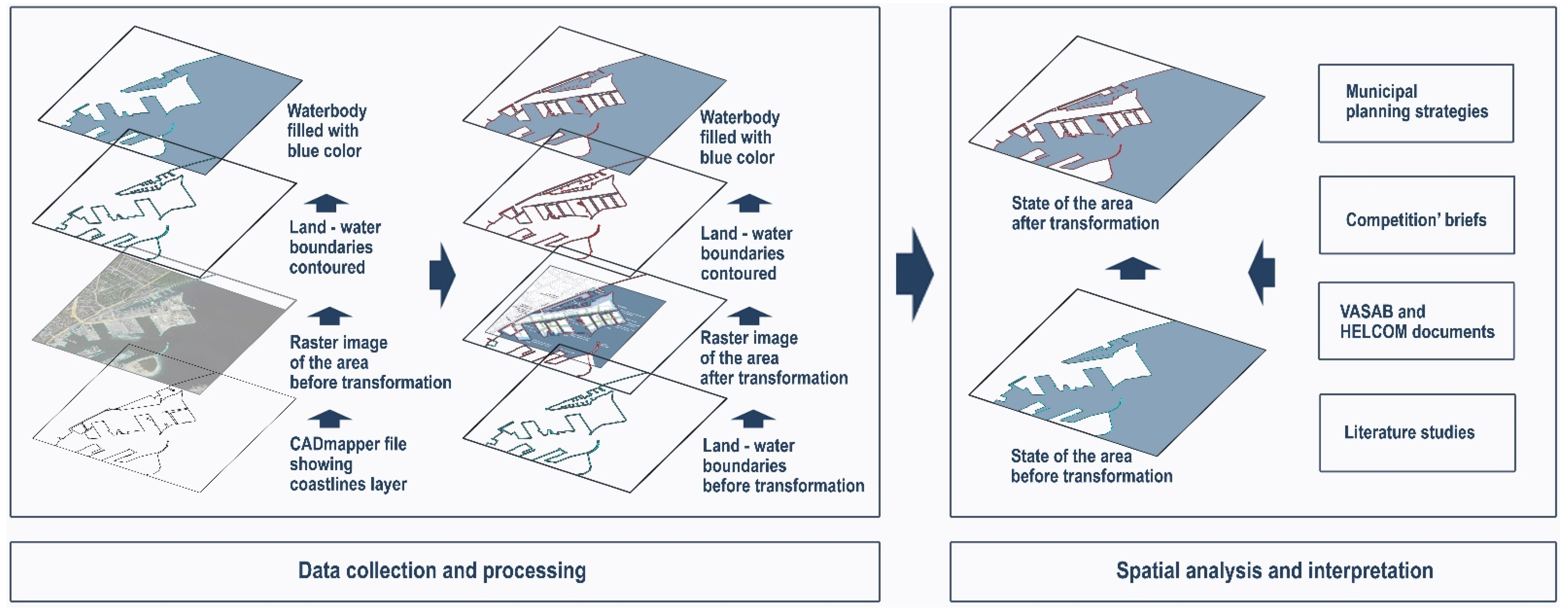
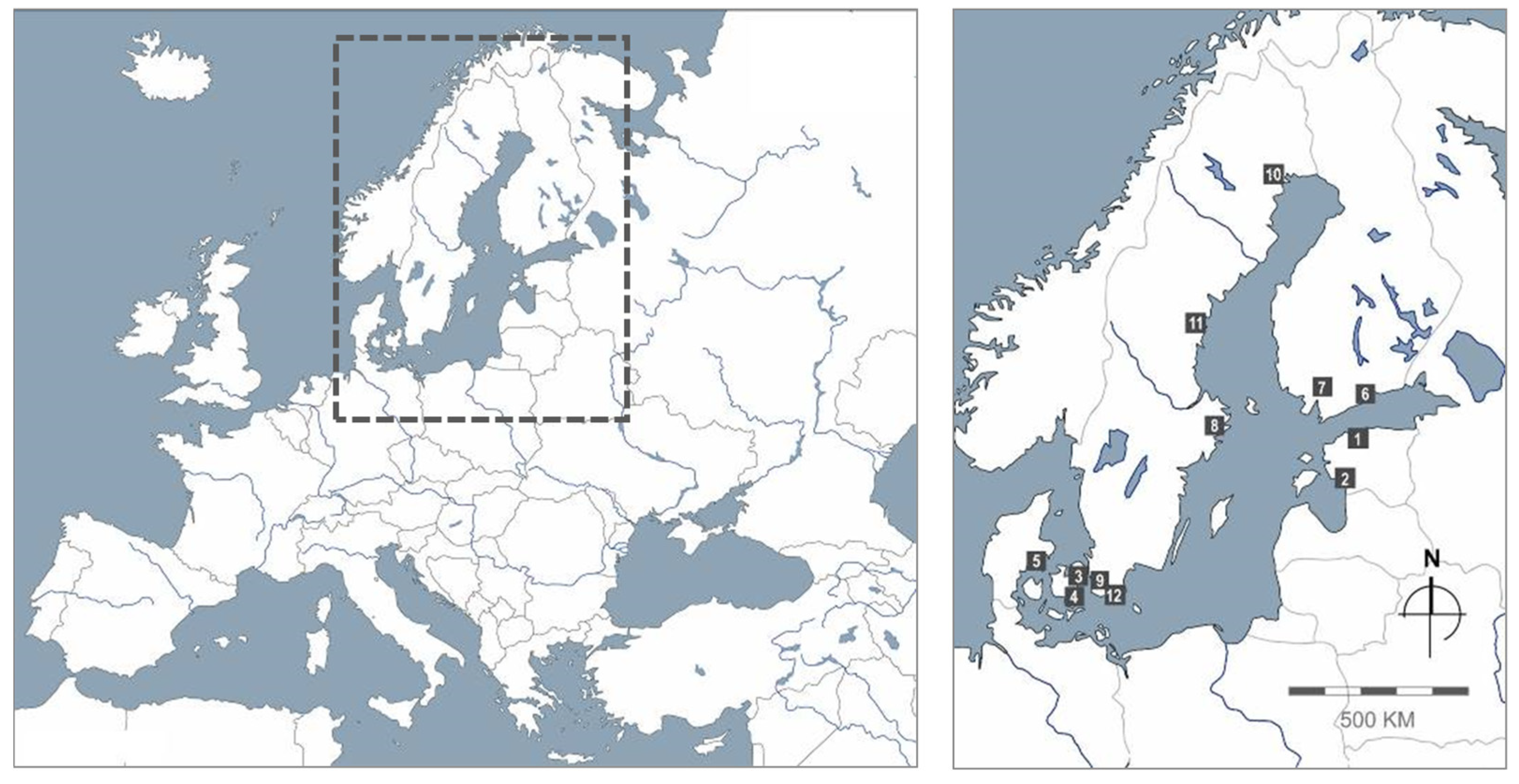

| Case No. | City | Location | Waterbody | Population 1 | Population Density (Population/km2) | Climate Zone | Average Lowest and Highest Temperatures (in Winter and Summer) | Annual Rainfall Approximately | Total Area 1 (km2) | Transformation Area in Relation to the Total City Area (% of City Area) 2 |
|---|---|---|---|---|---|---|---|---|---|---|
| 1. | Tallinn | Estonia | Gulf of Finland | 439,632 | 3.750 | humid continental | −5–20 °C | 600–700 mm | 117.2 | 0.46 |
| 2. | Pärnu | Estonia | Pärnu River | 40,228 | 1.214 | humid continental | −6–22 °C | 600–700 mm | 33.1 | 0.13 (1.36) |
| 3. | Copenhagen | Denmark | Øresund Strait | 653,664 | 7.407 | oceanic | 0–22 °C | 600–700 mm | 88.25 | 4.08 |
| 4. | Køge | Denmark | Køge Bay | 38,304 | 2.063 | temperate oceanic | 0–22 °C | 600–700 mm | 18.57 | 1.72 |
| 5. | Aarhus | Denmark | Aarhus Bay | 285,273 | 2.900 | temperate oceanic | 0–22 °C | 700–800 mm | 98.4 | 1.12 |
| 6. | Helsinki | Finland | Gulf of Finland | 664,028 | 3.099 | humid continental | −5–to 20 °C | 600–700 mm | 214 | 1.1 |
| 7. | Turku | Finland | Aura River | 283,305 | 992.7 | humid continental | −5–21 °C | 700–800 mm | 285 | 0.12 |
| 8. | Stockholm | Sweden | Lakes-Mälaren, Saltsjön; Canals; Straits-Lilla Värtan | 984,748 | 5.260 | humid continental & oceanic | −3–22 °C | 550–650 mm | 187.2 | 0.1 (1.26) |
| 9. | Malmö | Sweden | Öresund Strait | 357,377 | 2.277 | oceanic | 0–22 °C | 600–700 mm | 156.9 | 1.19 |
| 10. | Luleå | Sweden | Gulf of Bothnia | 49,123 | 1.727 | subarctic which borders on a humid continental | −10–20 °C | 500–600 mm | 28.45 | 2.11 |
| 11. | Sundsvall | Sweden | Gulf of Bothnia | 58,813 | 1.419 | subarctic and humid continental | −7–20 °C | 600–700 mm | 41.44 | 1 |
| 12. | Ystad | Sweden | Baltic Sea | 20,195 | 1.838 | temperate oceanic | 0–20 °C | 600–700 mm | 11.0 | 2.73 |
| Case No. | Transformation Site | Area of the Site | Site Plan Before Transformation | Transformation Results | Case Data:
|
|---|---|---|---|---|---|
| 1. | Tallin, Old City Harbour | 54 ha | 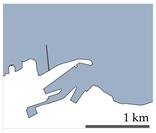 | 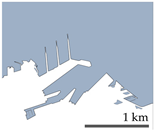 |
|
| 2. | Pärnu, Baltic Sea Art Park | 4.2 (45) | 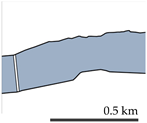 | 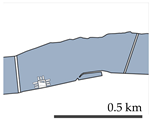 |
|
| 3. | Copenhagen, Nordhavn | 360 | 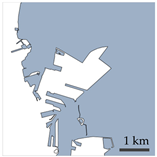 | 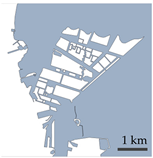 |
|
| 4. | Køge, Køge Coast | 32 | 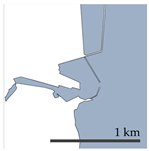 | 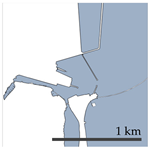 |
|
| 5. | Aarhus, Aarhus Ø | 110 | 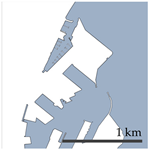 | 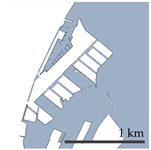 |
|
| 6. | Helsinki, Ruoholahti, Länsisatama, Jätkäsaari | 236 | 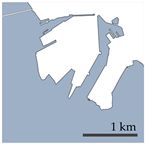 | 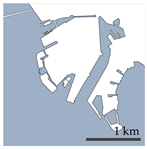 |
|
| 7. | Turku, Linnanniemi | 35 | 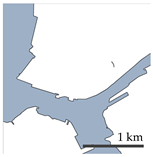 | 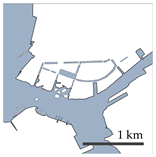 |
|
| 8. | Stockholm, Kolkajen-Ropsten, northern part of Stockholm Royal Seaport | 18 (236) | 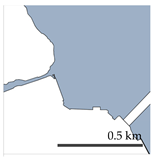 | 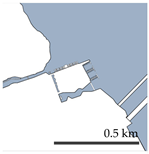 |
|
| 9. | Malmö, Västra Hamnen | 187 | 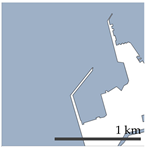 | 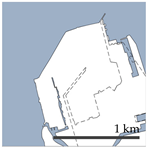 |
|
| 10. | Luleå, Södra Hamnleden | 60 | 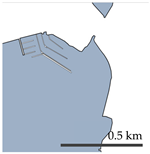 | 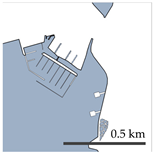 |
|
| 11. | Sundsvall, Norra Kajen | 41.5 | 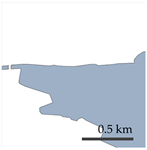 | 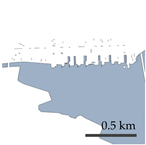 |
|
| 12. | Ystad, Ystad Hamn | 30 | 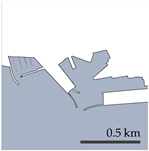 | 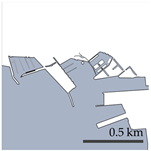 |
|
| Case No. | Site Plan Details of UBS | Transformation Results | |
|---|---|---|---|
| Forms of UBS | Flood Protection Measures | ||
| 1. |  |
|
|
| 2. |  |
|
|
| 3. |  |
|
|
| 4. |  |
|
|
| 5. |  |
|
|
| 6. |  |
|
|
| 7. |  |
|
|
| 8. |  |
|
|
| 9. |  |
|
|
| 10. |  |
|
|
| 11. |  |
|
|
| 12. |  |
|
|
Disclaimer/Publisher’s Note: The statements, opinions and data contained in all publications are solely those of the individual author(s) and contributor(s) and not of MDPI and/or the editor(s). MDPI and/or the editor(s) disclaim responsibility for any injury to people or property resulting from any ideas, methods, instructions or products referred to in the content. |
© 2023 by the authors. Licensee MDPI, Basel, Switzerland. This article is an open access article distributed under the terms and conditions of the Creative Commons Attribution (CC BY) license (https://creativecommons.org/licenses/by/4.0/).
Share and Cite
Burda, I.M.; Nyka, L. Innovative Urban Blue Space Design in a Changing Climate: Transition Models in the Baltic Sea Region. Water 2023, 15, 2826. https://doi.org/10.3390/w15152826
Burda IM, Nyka L. Innovative Urban Blue Space Design in a Changing Climate: Transition Models in the Baltic Sea Region. Water. 2023; 15(15):2826. https://doi.org/10.3390/w15152826
Chicago/Turabian StyleBurda, Izabela Maria, and Lucyna Nyka. 2023. "Innovative Urban Blue Space Design in a Changing Climate: Transition Models in the Baltic Sea Region" Water 15, no. 15: 2826. https://doi.org/10.3390/w15152826
APA StyleBurda, I. M., & Nyka, L. (2023). Innovative Urban Blue Space Design in a Changing Climate: Transition Models in the Baltic Sea Region. Water, 15(15), 2826. https://doi.org/10.3390/w15152826






